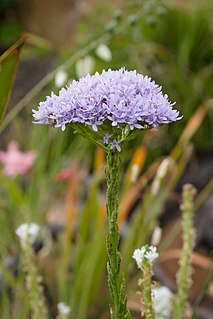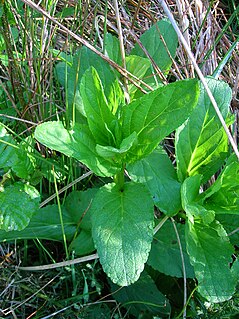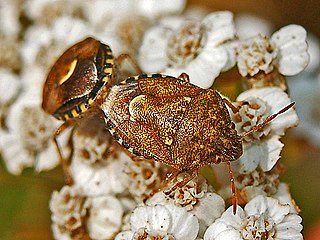
The Scrophulariaceae are a family of flowering plants, commonly known as the figwort family. The plants are annual and perennial herbs, as well as shrubs. Flowers have bilateral (zygomorphic) or rarely radial (actinomorphic) symmetry. The Scrophulariaceae have a cosmopolitan distribution, with the majority found in temperate areas, including tropical mountains. The family name is based on the name of the included genus Scrophularia L.

The genus Scrophularia of the family Scrophulariaceae comprises about 200 species of herbaceous flowering plants commonly known as figworts. Species of Scrophularia all share square stems, opposite leaves and open two-lipped flowers forming clusters at the end of their stems. The genus is found throughout the Northern Hemisphere.

Scrophularia marilandica, also called late figwort, Maryland figwort, carpenter's square, or eastern figwort, is a flowering plant in the family Scrophulariaceae, native throughout eastern and central North America, where it is found growing in dry woods from Manitoba and Quebec south to Texas and Florida.

A bog garden employs permanently moist soil to create a habitat for plants and creatures which thrive in such conditions. It may exploit existing poor drainage in the garden, or it may be artificially created using pond liners or other materials to trap water in the area. Any such structure must allow a small amount of seepage to prevent the water stagnating. For instance, a pond liner must be pierced a few times. Typically a bog garden consists of a shallow area adjoining a pond or other water feature, but care must be taken to prevent water draining from a higher to a lower level. The minimum sustainable depth is 40–45 cm (16–18 in). Good drainage is provided by gravel placed over the liner, and the bog can be kept watered by using a perforated hose below the surface.

Teucrium scorodonia, common name the woodland germander or wood sage, is a species of flowering plant in the genus Teucrium of the family Lamiaceae. It is native to Western Europe and Tunisia, but cultivated in many places as an ornamental plant in gardens, and naturalized in several regions.

Scrophularia nodosa is a perennial herbaceous plant found in temperate regions of the Northern hemisphere except western North America. It grows in moist and cultivated waste ground.

Selago is a genus of plants in the family Scrophulariaceae, closely related to Scrophularia and Verbascum. It contains around 190 species, mostly in southern Africa; two are listed on the IUCN Red List:

Scrophularia californica is a flowering plant in the figwort family which is known by the common names California figwort and California bee plant.

Scrophularia umbrosa, the green figwort, is a perennial herbaceous plant found in Europe and Asia. It grows in moist and cultivated waste ground.

Scrophularia lanceolata is a species of flowering plant in the figwort family known by the common names lanceleaf figwort and American figwort. It is native to North America, where it is known from western and eastern Canada and much of the United States except for the southeastern quadrant. Past common names include Western figwort when the western US plants were grouped under the name Scrophularia occidentalis and the eastern US plants were called Scrophularia leporella with the common name hare figwort.
Westernhope Burn Wood is a Site of Special Scientific Interest in the Wear Valley district of south-west County Durham, England. It occupies the steeply-incised ravine of the Westernhope Burn, a tributary of the River Wear, which it joins from the south about halfway between the villages of Eastgate and Westgate.

Scrophularia auriculata, the shoreline figwort or water figwort, is a perennial plant of the genus Scrophularia in the family Scrophulariaceae. It is found commonly in Western Europe and North Africa, on the margins of rivers, ponds and similar damp places. It is an upright plant reaching 70 cm with blunt oval, crenate leaves in alternate pairs on the greenish–purple square stem, most leaves may have two small lobes at their base. The spikes of flowers are held stiffly on square stems which arise from the main stem in the angle of the leaf stalks. The square stems have a wing running down each corner. These wings are more obvious than on the closely related common figwort. The flowers are small, maroon-brownish and globular with two small lips above and below. The five sepals are green with a white margin, broader on the water figwort than the common figwort. The plant flowers from June to September after when the flowers produce small spherical to pear-shaped capsules containing a large number of seeds.

Dvorichanskyi National Park is a national park in Ukraine, on the right bank of the Oskil river, in Eastern Ukraine. It was created in 2009, as a result of a presidential decree. The park is located in Kupiansk Raion, Kharkiv Oblast, near the Russian border. It covers 3,131 hectares of state-owned land.
Water figwort is a common name for several plants and may refer to:

Nothris congressariella is a moth in the family Gelechiidae. It was described by Charles Théophile Bruand d'Uzelle in 1858. It is found in Great Britain, Portugal, Spain, France, Switzerland, Italy, North Macedonia, Greece, and on Crete, Sardinia, Sicily and the Canary Islands.

King's Copse is a 13.7-hectare (34-acre) biological Site of Special Scientific Interest between Chapel Row and Clay Hill in Berkshire. It is in the North Wessex Downs, which is an Area of Outstanding Natural Beauty. The site is private land but a public footpath runs through it.

Cionus hortulanus is a species of weevils belonging to the family Curculionidae, subfamily Curculioninae.

Staria lunata is a species of shield bug belonging to the family Pentatomidae. It is the only species of the genus.

Scrophularia sambucifolia is a species of flowering plant in the figwort family (Scrophulariaceae) native to the Iberian Peninsula and Northwest Africa.

Scrophularia peregrina, the Mediterranean figwort, is a species of annual herb in the family Scrophulariaceae. They have a self-supporting growth form. Individuals can grow to 0.39 m.
















